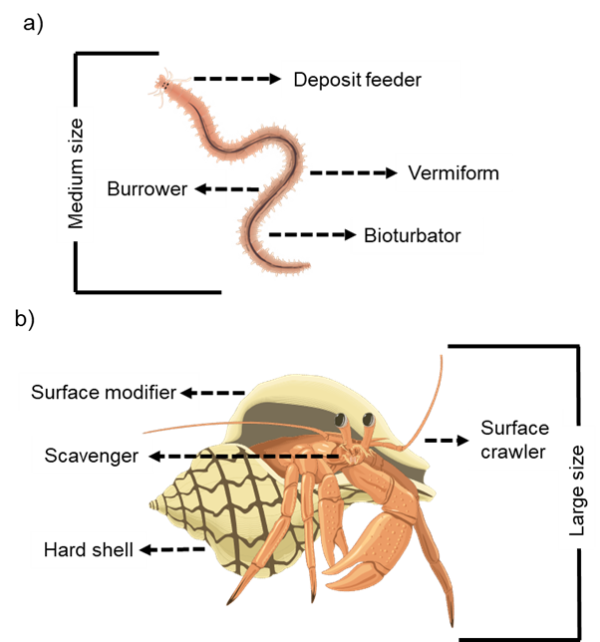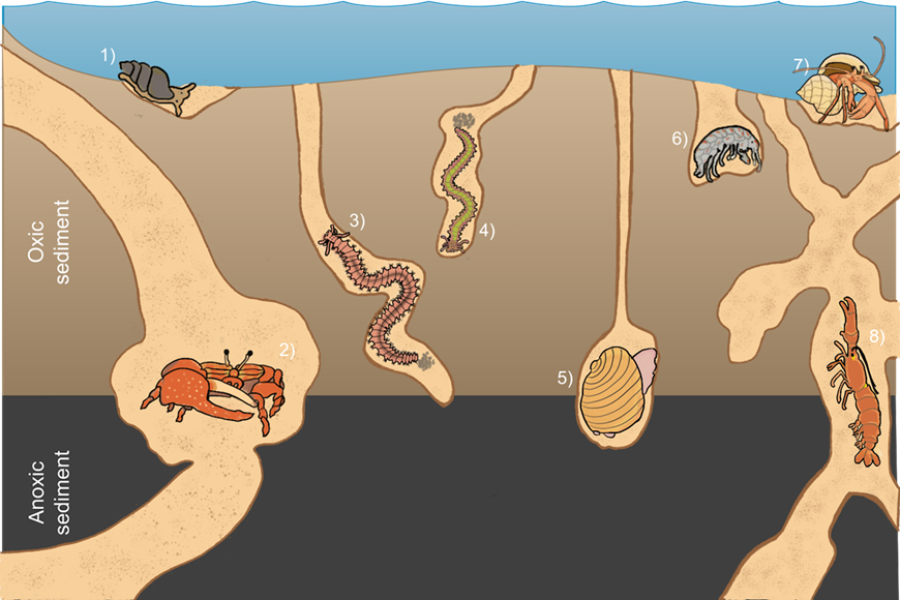Trait databases are essential for assessing ecosystems
Traits are defined as the components of organisms that can be measured and have an effect on ecosystem health. Examples of traits include the behaviour, life history, morphology, and physiological characteristics (Figure 1) that species may exhibit and that influence ecosystems, such as bioturbation, body size, feeding mode, living habit, and sediment position (Figure 2).
The use of traits has been proposed as a powerful tool for assessing biodiversity, since trait diversity and variability are related to changes in functions across ecosystems.
It is hoped this new information will be useful for assisting with the management of marine resources.
Research need
Macrobenthic organisms are currently threatened by anthropogenic pressures such as climate change, habitat disturbance, and eutrophication ("dead zone" regions), which are modifying the structure and distributions of their communities. Changes in macrobenthic communities and losses of biodiversity are affecting the functioning of ecosystems. Trait-based approaches have been proposed to understand the potential effects of biodiversity loss on the functioning of ecosystems, providing integrative knowledge of the links between biodiversity, functional traits, and ecosystems. Trait information is scare or non-existent in several parts of the world, such as New Zealand. This deficit makes collecting trait data a difficult and time-consuming task, limiting its potential use in trait-based assessments, which limits our understanding of how marine macrobenthic organisms are related to their ecosystems.
Establishing the New Zealand Trait Database (NZTD)
This is the first comprehensive assessment of macrobenthic traits to be made available since the New Zealand Trait Database (NZTD) for marine benthic invertebrates was established. The NZTD provides trait information for more than 700 macrobenthic taxa, categorised by 18 traits and 77 trait modalities. The NZTD aims to close knowledge gaps on macrobenthic trait information and advance trait-based approaches in New Zealand.
The NZTD includes five freely downloadable databases:
- Macrobenthic trait database
- Trait source information
- References by taxa list
- Full references list
- Full taxa list
Present research
Traits information is being used to increase our understanding of the relationships between:
- Biodiversity and ecosystems (contact Orlando Lam-Gordillo)
- Functional diversity and ecosystems (contact Drew Lohrer)
- Taxonomic and functional approaches (contact Orlando Lam-Gordillo)
- Trait information is also being used to explore stressor relationships in an effort to predict sudden ecological responses to cumulative effects (contact Drew Lohrer)
- Species and levels of diversity in different marine ecosystems (contact Drew Lohrer)
References
Bremner, J., Rogers, S.I., Frid, C.L.J., 2003. Assessing functional diversity in marine benthic systems: a comparison of approaches. Mar. Ecol. Prog. Ser. 254, 11–25. https://doi.org/10.3354/meps254011
Bremner, J., Rogers, S.I., Frid, C.L.J., 2006. Methods for describing ecological functioning of marine benthic assemblages using biological traits analysis (BTA). Ecol. Indic. 6, 609–622. https://doi.org/10.1016/j.ecolind.2005.08.026
Díaz, S., Cabido, M., 2001. Vive la difference: plant functional diversity matters to ecosystem process. Trends Ecol. Evol. 16, 646-655. https://doi.org/10.1016/S0169-5347(01)02283-2
Lam-Gordillo, O., Baring, S., Dittmann, S. 2020. Ecosystem functioning and functional approaches on marine macrobenthic fauna: A research synthesis towards a global consensus. Ecol. Indic. 115:00-00. https://doi.org/10.1016/j.ecolind.2020.106379
Lam‐Gordillo, O., Baring, R., Dittmann, S. 2020. Establishing the South Australian Macrobenthic Traits (SAMT) database: A trait classification for functional assessments. Ecol Evol 10:14372-14387. https://doi.org/10.1002/ece3.7040
Petchey, O.L., and Gaston, K.J., 2006. Functional diversity: back to basics and looking forward. Ecol. Lett. 9, 741-758.




